| |
| |
Photographer,
Location |
Images |
Comments |
|
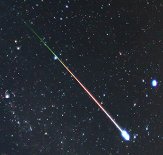
|
Pete
Lawrence,
Selsey, West Sussex, UK
Aug. 12, 2009 |
#1,
#2 |
Gotcha!
The distinctive colour change as the meteor comes through
the atmosphere can clearly be seen here as well as a pair
of terminal bursts as the Perseid meteoroid finally meets
its end. |
|
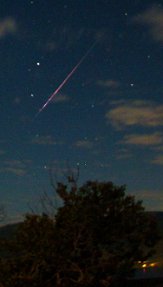
|
Jimmy
Westlake,
Steamboat
Springs, Colorado.
Aug. 12, 2009 |
#1,
#2 |
Here
are two bright Perseid fireballs that fell during a spike
in activity between 1:30 and 2:30 o'clock MDT on August
12, 2009.
The
first one (Perseid 47) is a 30-sec exposure taken at 1:48
am MDT. The second one (Perseid 94 - the brightest of the
night) was captured at 2:14 am MDT. Both were taken with
a Fuji Finepix Pro S2 digital camera set at ISO 400 with
a 16 mm wide angle lens at f2.8.
Moonlight
enhances the scene looking out over Stagecoach Lake near
Steamboat Springs, Colorado.
|
|
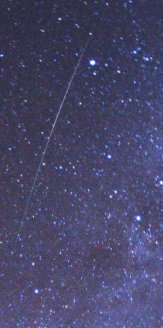
|
Mila
Zinkova,
Fremont Peak State Park, California, USA
Aug. 11, 2009 |
#1,
#2,
#3,
more |
I
started to look for Perseids at around 9:30 p.m. on August
11. Milky Way and long sparkling meteors made a dazzling
scenery. Later on the rising Moon slowly washed away Milky
Way and most meteors. |
|
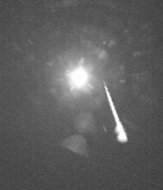
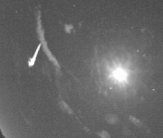
|
Bill
Cooke,
NASA Meteoroid Environment Office, Huntsville, Alabama
Aug. 10, 2009 |
#1,
#2 |
NASA astronomer Bill Cooke
operates a pair of all-aky meteor cameras separated by 100
miles--one in Alabama and one in Georgia. This Moon-bright
Perseid fireball was captured by both cameras on August
10th. Using simple principles of parallax and triangulation,
he was able to estimate the meteor's height (100 km), velocity
(59 km/s), and its 3D trajectory through the atmosphere.
Stay tuned for more of these as the shower unfolds. |
|
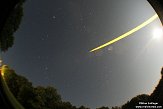
|
Brian
Emfinger,
Ozark, Arkansas
Aug. 10, 2009 |
#1,
#2,
more |
I
have had my camera out all night the last two nights with
a fisheye lens and have only been able to capture a handful
of dim meteors. Most of the meteors I have seen are dim
and fast and with The Moon...they are difficult to photograph.
I did catch this magnitude -8 Lightning
Bug Fireball that was outshone only by the Moon. The
lightning bug must have been just a inch above the lens.
The 2nd
pic is a dim Perseid Meteor from early this morning.
Photo
details: Canon
Digital Rebel XT, ISO 1600, F3.5, 1 min exposure. |
more
images: from
Doug Zubenel of St. Philippine Duchesne Memorial Park, Linn
Co., Kansas; from
Peter Elzinga of Burgum, Netherlands; from
Steve Paluch of Milwaukee, WI; from
Becky Ramotowski of Tijeras, New Mexico; from
Dave P Smith of Bluebell Hill, Chatham, Kent, UK; from
Victor van Wulfen of 's-Hertogenbosch, the Netherlands;
|
|